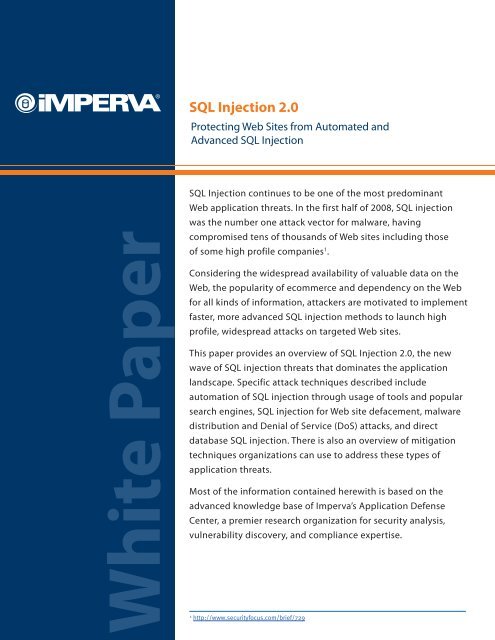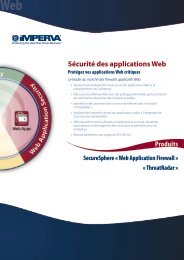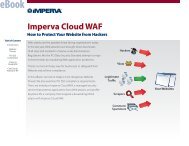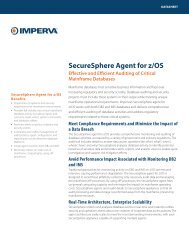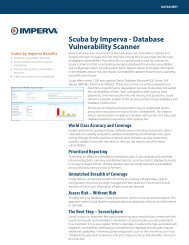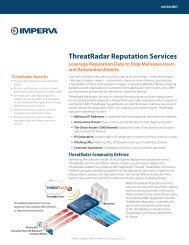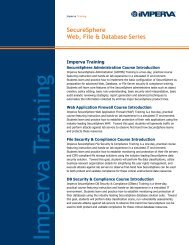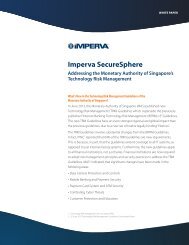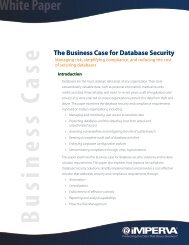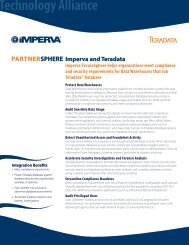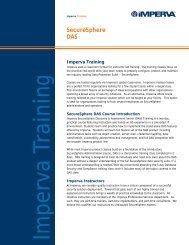SQL Injection 2.0 - Imperva
SQL Injection 2.0 - Imperva
SQL Injection 2.0 - Imperva
You also want an ePaper? Increase the reach of your titles
YUMPU automatically turns print PDFs into web optimized ePapers that Google loves.
<strong>SQL</strong> <strong>Injection</strong> <strong>2.0</strong>Protecting Web Sites from Automated andAdvanced <strong>SQL</strong> <strong>Injection</strong>White Paper<strong>SQL</strong> <strong>Injection</strong> continues to be one of the most predominantWeb application threats. In the first half of 2008, <strong>SQL</strong> injectionwas the number one attack vector for malware, havingcompromised tens of thousands of Web sites including thoseof some high profile companies 1 .Considering the widespread availability of valuable data on theWeb, the popularity of ecommerce and dependency on the Webfor all kinds of information, attackers are motivated to implementfaster, more advanced <strong>SQL</strong> injection methods to launch highprofile, widespread attacks on targeted Web sites.This paper provides an overview of <strong>SQL</strong> <strong>Injection</strong> <strong>2.0</strong>, the newwave of <strong>SQL</strong> injection threats that dominates the applicationlandscape. Specific attack techniques described includeautomation of <strong>SQL</strong> injection through usage of tools and popularsearch engines, <strong>SQL</strong> injection for Web site defacement, malwaredistribution and Denial of Service (DoS) attacks, and directdatabase <strong>SQL</strong> injection. There is also an overview of mitigationtechniques organizations can use to address these types ofapplication threats.Most of the information contained herewith is based on theadvanced knowledge base of <strong>Imperva</strong>’s Application DefenseCenter, a premier research organization for security analysis,vulnerability discovery, and compliance expertise.1http://www.securityfocus.com/brief/729
<strong>SQL</strong> <strong>Injection</strong> <strong>2.0</strong>Overview of <strong>SQL</strong> <strong>Injection</strong>This white paper assumes you have a working knowledge of <strong>SQL</strong> injection. However, a brief refresher on <strong>SQL</strong>injection is provided here. For additional information, you may refer to previous <strong>Imperva</strong> white papers on thistopic: “SecureSphere <strong>SQL</strong> <strong>Injection</strong> Protection White Paper” and “Blindfolded <strong>SQL</strong> <strong>Injection</strong>.”<strong>SQL</strong> injection is an attack technique that takes advantage of non-validated input vulnerabilities to pass <strong>SQL</strong>commands through a Web application for execution by a back-end database. Most <strong>SQL</strong> injection attacks areexecuted through an application that accepts user-supplied input for query parameters. The attacker suppliesa carefully crafted string within a form field or URL parameter to form a new query with results that are verydifferent from what the application developer intended.For example, consider a login form on a Web site that takes a username and password parameter to enableaccess to a certain section of the Web site by validating the username and password against entries in theback-end database. A very simple attack may be possible by simply providing something, like ‘a’ OR 1=1 -- in theusername field. Here we illustrate the <strong>SQL</strong> query that is generated when a user logs into a Web application:SELECT * FROM users WHERE username =’$uid’ AND password = ‘$pwd’;Suppose the hacker enters the username as ‘a’ OR 1=1 --. Then the <strong>SQL</strong> query becomesSELECT * FROM users WHERE username =’a’ OR 1=1 --’ AND password = ‘pwd’Because the double hyphens character is interpreted as the beginning of a comment by the <strong>SQL</strong> server,everything after ‘--’ is ignored. So the query effectively becomes:SELECT * FROM users WHERE username = ‘a’ OR 1=1;Since 1=1 is always true, the condition is always true and the login is always validated. Once the attacker hasgained access to the application, he may then perform reconnaissance to find out the structure of the database,learn about sensitive data tables and ultimately steal sensitive information.While the example above shows how <strong>SQL</strong> injection can be abused to gain unauthorized application access, most<strong>SQL</strong> <strong>Injection</strong> attacks are aimed at gaining unauthorized access to data within the backend database.Automation of <strong>SQL</strong> <strong>Injection</strong>The sheer number of compromised servers this year leaves no doubt that the hackers have stepped up theirefficiency using automated tools. Automation, from a hacker’s viewpoint, may expedite a number of distinctprocesses: discovery of attack targets, construction of a working exploit and extraction of data (in particularwhen a binary search technique is required). Two approaches are increasingly combined together for providingautomation in <strong>SQL</strong> injection attacks: dedicated desktop tools and search engine hacking.<strong>SQL</strong> <strong>Injection</strong> through Automation with ToolsTools are mainly used for automating two tasks within the <strong>SQL</strong> injection attack process: construction of aworking exploit and extracting information. Having automated tools at hand not only dramatically increase theefficiency of an experienced hacker but also extends the potential attacker population. Software tools equippedwith a crisp and appealing GUI, allow inexperienced “script kiddies” to mount complex <strong>SQL</strong> injection attacksagainst targets previously requiring in-depth knowledge of hacking techniques (e.g. blind <strong>SQL</strong> injection) andacquaintance with the backend database vendor technology (including structure of data dictionary, specific<strong>SQL</strong> strand, etc.). The overall effect of automation can be clearly depicted by looking at information regarding<strong>SQL</strong> incidents.With the daunting, time-consuming task of creating a working exploit taken care of by automated tools the timeframe between target discovery and full exploitation is greatly diminished. This has two favorable effects forpotential attackers. First and foremost, the risk for detection is lower, as the attack duration shortens. This is astrue in real life heists as it is for the cyberspace ones. Secondly, it is much easier for attackers to find a window ofopportunity to launch their attack, even against systems that are carefully watched and not always available forremote exploit.<strong>Imperva</strong> White Paper< 2 >
<strong>SQL</strong> <strong>Injection</strong> <strong>2.0</strong>Not all tools are created alike. Some are targeted towards specific vendor brands; some perform only a singletask while others are more comprehensive. Some are command-line tools while others have a lavish GUI.Generally speaking, there are now tools that provide the following capabilities:» Given an injection point (URL and parameters), create a working exploit.» Achieve the above goal even when blind <strong>SQL</strong> injection is required» Identify type of backend database» Extract metadata from backend database (list of tables, columns and users)» Extract information through GUI» Extract information through binary search» Compromise remote server by deploying backdoorsThese are some of the tools being employed by hackers to automate <strong>SQL</strong> injection attacks:» Priamos can be used to find vulnerabilities in applications. The tool requires manual configuration of the injectionpoint, but thereafter, the user can apply the vulnerable character string into the injector module in Priamos toretrieve all database names, tables and column data. It presents a GUI to the user for direct database interaction.» Power Injector does some automatic detection of the injection point and provides a GUI to take the <strong>SQL</strong> injectionattack further from that point in order to extract desired information from the database. Its power lies in itscapacity to automate tedious blindfolded <strong>SQL</strong> injection methods with several threads.» <strong>SQL</strong> Ninja can be used to exploit <strong>SQL</strong> injection vulnerabilities on a Web application that uses Microsoft <strong>SQL</strong> Serveras its back-end database. It requires manual configuration of the injection point. It is dedicated to exploitinginjections into a specific stored procedure of the database server called Xp_cmdshell.» <strong>SQL</strong> Map does some of its automated detection of the injection point based on Google searches. It performsautomatic blind <strong>SQL</strong> injection, capable of capturing an active database management system fingerprint,enumerating entire remote databases and much more.These are just a few of the more common and publicized tools, but there are many more tools that have beenand continue to be developed by professional attackers with the purpose of automating <strong>SQL</strong> injection attacks.An attacker with the appropriate toolbox and an idea about potential injection points in an application needsno more than click and point to get away with credit card numbers, social security numbers and other personalinformation stored in a backend database.<strong>SQL</strong> <strong>Injection</strong> through Automation with Search EnginesWhile tools are mostly used for reducing the time from vulnerability detection to exploit, another type ofautomation is required for quickly detecting large quantities of potential targets. The growing trend is theincreased abuse of Internet search engines for spotting potential <strong>SQL</strong> injection targets.Using specially crafted search terms, an attacker can quickly get a list of applications, accessible through theInternet, that are potentially vulnerable to a specific instance of <strong>SQL</strong> injection. Search terms can be created todetect a specific vulnerable application (e.g. one that was identified as vulnerable by a CVE entry) or a specificerror code indicative of <strong>SQL</strong> injection vulnerability. The results include not only a domain name for the targetapplication but the actual injection points within that application. Thus, an attack can be quickly mountedby taking the information from the search engine results and feeding them to one of the automated toolsmentioned above.Attackers can craft their own search terms but can also use resources available on the Internet that provide listsof search terms for almost any type of attack, <strong>SQL</strong> injection included. One of the most famous resources in thisrespect is Johnny Long’s Google Hacking Database maintained at johnny.ihackstuff.com. The search terms onJohnny’s database, called “Google Dorks” are categorized by attack type and the interface to the database isvery intuitive.<strong>Imperva</strong> White Paper< 3 >
<strong>SQL</strong> <strong>Injection</strong> <strong>2.0</strong>Further increasing the potential effect of the Google Hacking technique on improving the overall efficiency of anattack is the use of automated search tools. These simple robots take as input a list of search terms, run them allat once and give back a formatted set of results. Attackers can use their own tools (creating such a tool can be areally simple programming exercise) or use available tools from the Internet such as Goolag Scanner (by The Cultof the Dead Cow). This tool in particular takes its list of search terms from Johnny Long’s database and makesthem available to the non-technical user through a pleasant, easy-to-use GUI.Earlier this year, hackers used search engines to quickly find ASP and ASPX (.net) pages that accepted a set ofcarefully chosen input parameters (e.g.an article ID, product ID and others) which they suspected are indicativeof a number of poorly written modules available worldwide (most probably code samples widely used byprogrammers). This served as the injection point for the successful upload of <strong>SQL</strong> injection code in over 500,000Web pages. The code caused a user who visited the site to be redirected to a malware serving site. Affectedcompanies were forced to quickly investigate and sanitize the Web sites by removing the injected code 2 .<strong>SQL</strong> <strong>Injection</strong>: Going Beyond Data TheftAlthough <strong>SQL</strong> injection has most commonly been associated with the extraction of valuable data throughWeb applications, it is also increasingly being utilized as a platform for launching other types of Web basedattacks including Web site defacement, malware distribution (aka “Drive-by download attacks”), and Denial ofService (DoS).<strong>SQL</strong> <strong>Injection</strong> for Web site defacementWeb site defacement traditionally occurred when a hacker obtained administrative privileges to a Web site andthen altered the content of the Web site with potentially offensive or erroneous graphics and text. While Web siteowners have bolstered the security of Web configuration tools, malicious users have discovered a new techniqueto deface Web sites: <strong>SQL</strong> injection.In 2007, there were several high profile incidents in which <strong>SQL</strong> injection was used for Web site defacement. Infact, the Microsoft UK 3 site and the United Nations 4 (UN) sites were defaced within just months of each other in2007. This type of attack is made possible when the injection point allows not only tampering with the criteriaof a SELECT statement but also appending additional <strong>SQL</strong> statements such as INSERT or UPDATE. In particular,an attacker can construct an UPDATE statement to tamper with the contents of database columns that are laterembedded in HTML pages. The attacker would replace the original content of such columns with HTML codeto either change the appearance of a page (by embedding offensive images) or silently redirecting a client to amalware hosting server (by embedding IFRAME tags).Because this type of Web site defacement affects the backend database rather than the static Web applicationfiles, even if there is a static change tracking system or change management system being used, neither of thesemechanisms would detect the attack.<strong>SQL</strong> <strong>Injection</strong> for Malware DistributionOver the past year, there have been a number of publicized malware distribution incidents due to <strong>SQL</strong> injectionattacks. Many of the affected Web sites were high profile, high traffic volume based sites.<strong>SQL</strong> injection for malware distribution is an evolution of the same technique that is used for Web sitedefacement. This time however, the appended HTML element is not of a visible nature.Below we illustrate how this type of attack can take place. In this example, we will focus on Web site defacement,not how the <strong>SQL</strong> injection point was found in the application.2http://www.pcworld.com/article/145151/huge_web_hack_attack_infects_500000_pages.html3Microsoft UK site defacement: http://news.cnet.com/2100-7349_3-6194705.html4United Nations site defacement: http://www.pcworld.com/article/135879/hackers_deface_un_site.html<strong>Imperva</strong> White Paper< 4 >
<strong>SQL</strong> <strong>Injection</strong> <strong>2.0</strong>Step 1:The attacker modifies a <strong>SQL</strong> query by adding an IFRAME HTML element to all or some of the text fields inthe application’s database. The IFRAME includes a redirection to a server holding malware.Step 2:Once a victim accesses the compromised application, he would receive an HTML page with theinjection IFRAME.Step 3:The victim downloads malware from the attacker controlled server. Once the user visits the malware servingsite, Trojans or keystroke loggers are downloaded and automatically installed on the user’s machine. Oncea keystroke logger software application is on the machine, any personal information such as credit cardnumbers, bank passwords, or social security numbers can easily be extracted and subsequently misusedby the attacker.What makes this attack particularly difficult to detect is that it is executed without leaving behind any visualtrace. When the HTML page is rendered by the victim’s Web browser, what happens behind the scenes is that thevictim ends up downloading malware from the attacker-controlled server thinking that it is part of the legitimateWeb application.As part of a malware distribution attack, infecting all items in the database is not necessary. The attacker maychoose to infect a specific record that is known to be displayed for all users. Infecting all items of a database isaccomplished through the combination of a new attack target (data integrity) with a new method (automation).Because of <strong>SQL</strong> injection automation tools and search engines, hackers have been able to successfully injectmalware links in hundreds of thousands of Web sites. In fact, in January 2008 alone, at least 70,000 Web sites hadbeen affected by one particular automated <strong>SQL</strong> injection attack that exploited several common vulnerabilities ofthese sites, including a Microsoft <strong>SQL</strong> server vulnerability 5 .5Multiple Web sites affected by <strong>SQL</strong> injection based malware attack:http://www.scmagazineus.com/Mass-<strong>SQL</strong>-injection-attack-compromises-70000-websites/article/100497/<strong>Imperva</strong> White Paper< 5 >
<strong>SQL</strong> <strong>Injection</strong> <strong>2.0</strong><strong>SQL</strong> <strong>Injection</strong> for DoSAnother application threat related to <strong>SQL</strong> injection is Denial of Service (DoS), which, in its most extreme form,can bring the Web application to a halt by shutting down its backend database. It takes place when an attackerappends the SHUTDOWN command to a <strong>SQL</strong> statement, or when the attacker creates complex queries overself-joins of large database tables with the intention of sending the database into time consuming loops overlots of data. This ends up consuming precious CPU time within the database servers. These attack techniques aregenerally well known – they require true <strong>SQL</strong> injection and usually such complex queries require the existence ofvery large tables within the target database.What is relatively new is the use of search fields that perform “LIKE” comparisons of the search terms to induceDoS without users actually inputting an additional command or clause. So even if the application code is writtencorrectly, but the application fetches results based on just an approximated search of the backend database, theapplication might be vulnerable. This phenomenon is due to the way commercial databases implement the LIKEoperator. In particular this operator gives special “wild card” meaning to some characters (e.g., “%”, “[]”, “[^]”, etc.)up to the point of providing full regular expression capabilities.One of the most obvious implications of using specially crafted approximated search expressions is avoidingthe use of database indexes. This, by itself, consumes more processing resources in the database server sincean entire table needs to be scanned sequentially rather than a small index being partially traversed. In addition,the database engine applies complex regular expressions to every row in the table. Due to very long processingtimes, the application slows down because the application server’s resources are being fully consumed. Somestudies have shown that by using even a relatively short search term of a few characters over a relatively smalltable with just a couple thousand records, the search can easily consume all of the CPU’s power for thirty secondsor more. This is clearly a relatively simple, yet powerful method that can be used to induce DoS in an applicationeven if the application is not directly susceptible to <strong>SQL</strong> injection.Direct Database <strong>SQL</strong> <strong>Injection</strong>Another type of attack, one that is less prevalent in real world scenarios, but nevertheless, can cause majordamage to an organization if it succeeds, is a direct database <strong>SQL</strong> injection attack through database storedprocedures. A stored procedure is a collection of procedural <strong>SQL</strong> statements put together for the completion ofa single logical task and stored in the database server under a distinctive name. A person who writes a storedprocedure can grant execution privileges to other database users without having to grant them any privilegesover the underlying objects. An implication of this model is that the code within the stored procedure is (usually)executed in the security context of the procedure writer rather than the procedure caller. Hence if a storedprocedure is vulnerable to <strong>SQL</strong> injection, an attacker with execute privileges on that procedure can inject <strong>SQL</strong>statements that will be executed with the privileges of the procedure writer, most often an administrative user. Inthe following code snippet we can see that through the parameter RESULT_TABLE an attacker can inject changesto the update statement.<strong>Imperva</strong> White Paper< 6 >
<strong>SQL</strong> <strong>Injection</strong> <strong>2.0</strong>Commercial database platforms offer more and more functionality to their users through stored procedures,granting by default execution privileges to any database user over a growing set of those. Consequently, the riskof an internal user gaining elevated privileges is growing higher. However, direct database <strong>SQL</strong> injection posesrisk not only with respect to internal threats. Many Web applications make use of a database stored procedureto complete their tasks. As a consequence a <strong>SQL</strong> injection vulnerability in a stored procedure can be invokedthrough a Web facing application exposing it to external threats. One such example is a vulnerability reported byDavid Litchfield earlier in 2008, coded CVE-2008-2589. It is a <strong>SQL</strong> injection vulnerability in a built-in Oracle storedprocedure called WWV_RENDER_REPORT. The stored procedure forms part of the Oracle Portal software suiteand is accessible through a Portal URL. Therefore external attackers can easily abuse the stored procedure togain unauthorized access to all Portal data.Recent research 6 has also shown that while traditionally direct database <strong>SQL</strong> injection vulnerabilities areattributed to textual parameters they can also be attributed to parameters of type DATE, and even to procedureswith no parameters that use the SYSDATE function to get the current date.Mitigation TechniquesWhen dealing with <strong>SQL</strong> injection vulnerabilities, in a perfect world, organizations would: fix the applicationcode for discovered vulnerabilities by using input sanitation and using prepared statements with bind variables,test that the application is no longer vulnerable, and then redeploy the application. The drawback of thisapproach is that it takes a lot of time to fix application code. Also, in some cases, the application code is not evenavailable because the original application developers no longer work for the organization or the application wasdeveloped by subcontractors.Code Fix is Not a Solution for Every OrganizationEvery organization typically has a process that it must follow for fixing <strong>SQL</strong> injection and other types ofapplication vulnerabilities. Finding the vulnerabilities is only the beginning. The software code fix processinvolves working in synchronization with application developers and the QA team and coming to a consensuson a software development process designed to prevent developers from introducing flaws into criticalapplications. The following is an example of such a process:1. Investigate the application and identify the vulnerable code.2. Architect a solution in the source code to fix the vulnerability.3. Organizations with a change management process in place must also document the fix, perform a risk assessmentand get sign off before they can implement any changes to the application.4. Code the fix into the application.5. Test the application to make sure the fix solved the problem and didn't introduce new vulnerabilities.6. Follow a maintenance window – most organizations have a specific window and generally the larger theorganization, the smaller the window is. In certain cases, for critical vulnerabilities, an application may have to bebrought down for a very brief period and must be able to regress during that period of the deployment (when theapplication is not running).7. Deploy the application after it has been fixed for the vulnerability.Clearly, the above process is very resource and time consuming and following it for each and every vulnerabilityas soon as it is discovered is not a realistic option.A serious drawback of the code fix approach is that during the entire length of the process the applicationremains vulnerable to attacks. It is only after the application has been redeployed in step seven that theapplication is protected against that particular vulnerability. Another drawback is that changing the codemay introduce new vulnerabilities, for which the code would have to be re-scanned, and possibly changedand re-tested.6http://www.databasesecurity.com/dbsec/lateral-sql-injection.pdf<strong>Imperva</strong> White Paper< 7 >
<strong>SQL</strong> <strong>Injection</strong> <strong>2.0</strong>Another important point is that certain organizations use packaged business applications such as OracleE-Business Suite, SAP and PeopleSoft, and must depend on the vendors themselves to release a patch for thevulnerability fix. The organizations themselves cannot even perform a code fix. Therefore, they would probablyneed an alternative security solution to protect their applications on an ongoing basis.Traditional Security Methods are InsufficientNetwork firewalls and Intrusion Prevention Systems (IPS) attempt to identify <strong>SQL</strong> injection via traditionalsignature-based protections. The most common way of detecting <strong>SQL</strong> injection attacks is by looking for <strong>SQL</strong>signatures in the incoming HTTP stream. For example, looking for <strong>SQL</strong> commands such as UNION, SELECT or xp_.The problem with this approach is the high rate of false positives. Most <strong>SQL</strong> commands are legitimate words thatcould normally appear in the incoming HTTP stream. Ultimately, the security administrator will either disable orignore any <strong>SQL</strong> alert reported. In order to overcome this problem to an extent, the product should learn whereit should and shouldn't expect <strong>SQL</strong> signatures to appear. The ability to discern parameter values from the entireHTTP request and the ability to handle various encoding scenarios are an important requirement. Certain Webapplication firewall products address this need.Some organizations consider usage of vulnerability scanning technology, either static (code review) or dynamic(application vulnerability scanning), to address <strong>SQL</strong> injection and other application vulnerabilities. It should benoted that although these types of vulnerability scanning technologies assist in discovering vulnerabilities, theystill leave the organizations with the problem of mitigating them.To address <strong>SQL</strong> injection and other advanced application threats, a different solution, a Web application firewall,is required. Unlike network firewalls and IPS solutions, a Web application firewall understands how applicationswork and provides specific protection for applications against attacks based on both known and unknownvulnerabilities. Even an organization that has the resources available to fix application code will benefit fromdeploying a Web application firewall. With a Web application firewall deployed in front of critical application andWeb servers, the organization gets a larger window within which to fix its application code, rather than havingto schedule rush fixes each time a new application threat or variant of a known application threat is introduced.In addition to deploying a Web application firewall, the organization can schedule code fixes and third partypatching of the most critical areas of the application, much like an organization would do with any otherfunctional flow.One of the greatest challenges organizations face in <strong>SQL</strong> injection security solutions is properly tracking actualusers. The fundamental problem is that almost all Web applications use “pool accounts” so that while users areauthenticated to the Web application, they appear only as a single pooled account user to the database. Securityand compliance mandates make it critical to have a solution that will uniquely identify the end-users who areperforming activities via applications, even when connection pooling mechanisms are used for communicationbetween the Web application and associated database. The lack of visibility in these situations has seriousdisclosure and audit accountability issues. This capability is difficult to find in most products in the market, sincethey either address application or database security, but not both. However, <strong>Imperva</strong>’s SecureSphere productsaddress this important need.Preventing <strong>SQL</strong> <strong>Injection</strong> with SecureSphere Application DataSecurity SolutionsThe <strong>Imperva</strong> SecureSphere Web application firewall features advanced protection against <strong>SQL</strong> injection attacksand incorporates a multi-layer security model that enables precise attack protection from <strong>SQL</strong> injection withoutthe need for manual tuning. SecureSphere's security architecture incorporates both dynamic positive (white list)and dynamic negative (black list) security models. Robust enforcement algorithms draw on both security modelsto identify and block even the most sophisticated attacks. In addition, customers can easily upgrade from theSecureSphere Web application firewall to the SecureSphere Database Security Gateway, which adds advancedprotection against direct database <strong>SQL</strong> injection and other attacks targeted at the database.<strong>Imperva</strong> White Paper< 8 >
<strong>SQL</strong> <strong>Injection</strong> <strong>2.0</strong>Multi-Layered Approach for Protection against <strong>SQL</strong> <strong>Injection</strong>SecureSphere utilizes a multi-tiered approach for detecting of <strong>SQL</strong> injection, HTTP protocol validation, IPS basedsignatures, Dynamic Profiling, and Correlated Attack Validation.<strong>Imperva</strong> has developed specific protection against <strong>SQL</strong> injection through a dedicated <strong>SQL</strong> <strong>Injection</strong> alert that ispart of the SecureSphere security engine. By combining behavioral indications (character type / length violation,special characters, etc.) with anti-evasion mechanisms, simple pattern matching and fully fledged regularexpressions, SecureSphere is able to accurately defend application data against a wide range of <strong>SQL</strong> injectionthreats.» HTTP Protocol Validation prevents protocol exploits including buffer overflow, malicious encoding, HTTPsmuggling, and illegal server operations. Flexible policies enable strict adherence to RFC standards while allowingminor variations for specific applications.SecureSphere integrates Dynamic Profiling, IPS, and Correlated Attack Validation technologies to identify <strong>SQL</strong>injection with unmatched accuracy.» Dynamic Profiling delivers query-level access control by automatically creating profiles of each user andapplication’s normal query patterns. Any query (such as a <strong>SQL</strong> injection attack query) that does not matchpreviously established user or application patterns are immediately identified.SecureSphere’s Dynamic Profiling technology examines live traffic to automatically create a comprehensivemodel or “profile” of the site. Specific elements of the profile include dynamic URLs, HTTP methods, cookies,parameter names, parameter lengths, and parameter types. The profile then serves as a positive security modelfor the Web application. By continuously comparing user interactions to the profile, SecureSphere can detect anyunusual Web activity. As the Web site changes over time, advanced learning algorithms automatically update theprofiles to eliminate any need for manual tuning.Figure 1 presents a SecureSphere Dynamic Profile of a “Credit Card Number” parameter corresponding to theappropriate length of the Credit Card number that is entered into an online form of an ecommerce site:Figure 1: SecureSphere automatically builds a model of each Web application parameterThe SecureSphere positive-security model identifies the parameter as a required parameter consisting ofNumeric characters with a minimum and maximum length of sixteen characters. The insertion of more or lessthan sixteen characters into the parameter conflicts with the profile and a SecureSphere Parameter LengthViolation Alert is triggered.There are a number of <strong>SQL</strong> injection vulnerabilities that are well known, such as <strong>SQL</strong> query string patternsrelated to the basic “OR 1=1” evasion technique described earlier. These types of known threats can be mitigatedthrough signature pattern matching. Recognizing this, <strong>Imperva</strong> has incorporated IPS as part of its advancedsecurity engine to mitigate common vulnerabilities.» SecureSphere IPS includes unique database signature dictionaries designed specifically to identify vulnerablestored procedures and <strong>SQL</strong> injection strings, preventing database platform attacks. SecureSphere also has adatabase of <strong>SQL</strong> injection based signatures used for recognition of known <strong>SQL</strong> injection patterns found in userinput to Web applications quick and easy protection from known <strong>SQL</strong> injection attack, as well as protection fromknown network, operating system, and Web server software attacks. SecureSphere goes beyond a standaloneIPS product because it learns and understands application behavior (Dynamic Profiling) to accurately preventmalicious users from abusing legitimate applications and combines this with Correlated Attack Validation,resulting in a lower rate of false positives.» Correlated Attack Validation correlates security violations originating from multiple SecureSphere detectionlayers. By correlating multiple violations from the same user, SecureSphere is able to detect <strong>SQL</strong> injection with adegree of accuracy that is not possible using any single detection layer.<strong>Imperva</strong> White Paper< 9 >
<strong>SQL</strong> <strong>Injection</strong> <strong>2.0</strong>End-to-end Coverage for Applications and Databases EnablesStronger ProtectionBecause SecureSphere provides end-to-end coverage for protection against both database and Web applicationthreats, it enables complete protection against <strong>SQL</strong> injection attacks irrespective of the origin of the attack.SecureSphere goes beyond simple signature based mechanisms and IPS solutions. It observes the <strong>SQL</strong>communication and builds a profile consisting of all allowed <strong>SQL</strong> queries. Whenever a <strong>SQL</strong> injection attackoccurs, SecureSphere can detect the unauthorized query sent to the database. SecureSphere can also correlateanomalies on the <strong>SQL</strong> stream with anomalies on the HTTP stream to accurately detect <strong>SQL</strong> injection attacks.Therefore, SecureSphere offers a unique value in protecting actual applications and databases themselves, asopposed to just the supporting platforms and infrastructure software.SecureSphere provides effective protection against direct database <strong>SQL</strong> injection. SecureSphere creates anaccurate baseline database usage profile, tracking acceptable usage of the application, and maintains the profileon an ongoing basis on the database server. In real time, SecureSphere detects queries that deviate from thelearned profile and correlates them with information about the sensitive tables in the database. If it detects anunauthorized attempt to access sensitive data, SecureSphere will issue an alert and can block the user request.Conclusion<strong>SQL</strong> injection <strong>2.0</strong> threats impose a real danger to organizations that depend on the Web for informationexchange with and for providing valuable services to their partners and customers. <strong>SQL</strong> injection attacks areconstantly evolving, changing their shape and target. Relatively simple forms of <strong>SQL</strong> injection attacks arebecoming more widespread through usage of automation tools and popular search engines, while advanced<strong>SQL</strong> injection attacks are being crafted to more seamlessly bypass built-in security mechanisms withinapplications and databases.To protect critical business data from being compromised by <strong>SQL</strong> <strong>Injection</strong>, organizations should mitigate theknown vulnerabilities by deploying a Web application firewall in front of their applications, and they shouldfollow a regular code fix procedure for fixing the critical areas of the applications that are vulnerable due to somelogical business flaw.About the <strong>Imperva</strong> Application Defense CenterThe security and compliance experts at the <strong>Imperva</strong> Application Defense Center (ADC) conduct research onissues related to application and data security and compliance. The ADC is lead by Amichai Shulman, <strong>Imperva</strong>’sCTO who was named to InfoWorld Magazine’s “Top 25 CTOs of 2006” list. Automated feeds from the ADC ensurethat SecureSphere is always armed with the latest information about new security developments and regulatorycompliance best practices. This specific expertise in application and database security is unmatched in theindustry today.<strong>Imperva</strong> White Paper< 10 >
<strong>Imperva</strong>North America HeadquartersInternational Headquarters3400 Bridge Parkway 125 Menachem Begin StreetSuite 101 Tel-Aviv 67010Redwood Shores, CA 94065IsraelTel: +1-650-345-9000 Tel: +972-3-6840100Fax: +1-650-345-9004 Fax: +972-3-6840200Toll Free (U.S. only): +1-866-926-4678www.imperva.com© Copyright 2008, <strong>Imperva</strong>All rights reserved. <strong>Imperva</strong> and SecureSphere are registered trademarks of <strong>Imperva</strong>.All other brand or product names are trademarks or registered trademarks of their respective holders.#WP-<strong>SQL</strong>_INJECTION_<strong>2.0</strong>-1208rev1


